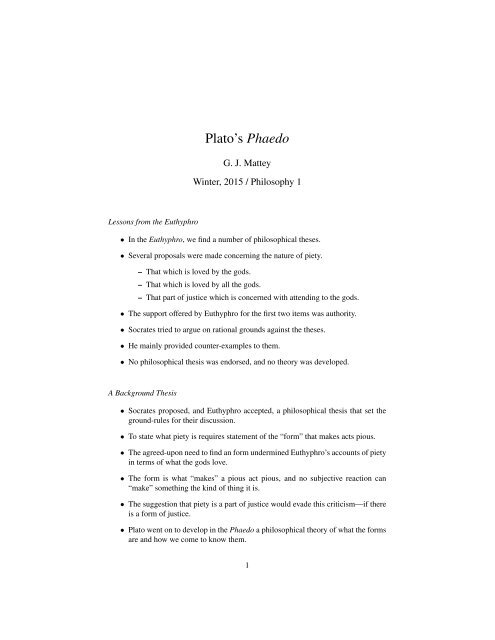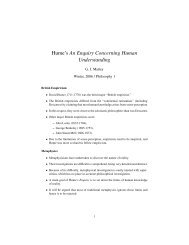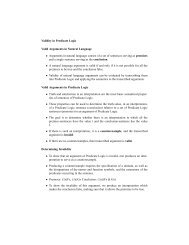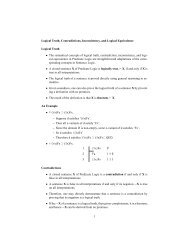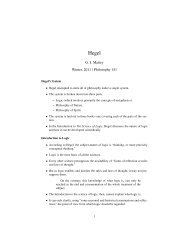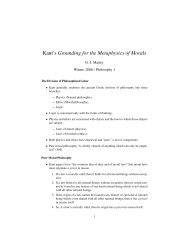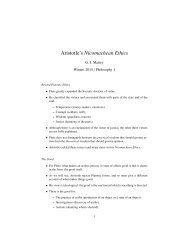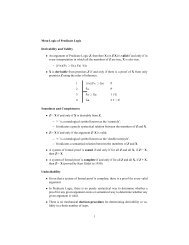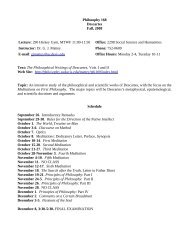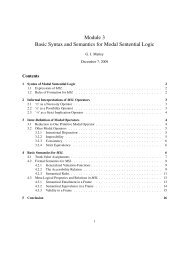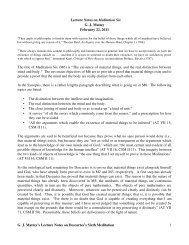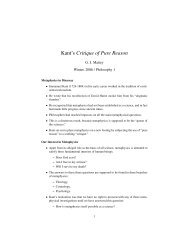Plato's Phaedo - the UC Davis Philosophy Department
Plato's Phaedo - the UC Davis Philosophy Department
Plato's Phaedo - the UC Davis Philosophy Department
Create successful ePaper yourself
Turn your PDF publications into a flip-book with our unique Google optimized e-Paper software.
Plato’s <strong>Phaedo</strong>G. J. MatteyWinter, 2015 / <strong>Philosophy</strong> 1Lessons from <strong>the</strong> Euthyphro• In <strong>the</strong> Euthyphro, we find a number of philosophical <strong>the</strong>ses.• Several proposals were made concerning <strong>the</strong> nature of piety.– That which is loved by <strong>the</strong> gods.– That which is loved by all <strong>the</strong> gods.– That part of justice which is concerned with attending to <strong>the</strong> gods.• The support offered by Euthyphro for <strong>the</strong> first two items was authority.• Socrates tried to argue on rational grounds against <strong>the</strong> <strong>the</strong>ses.• He mainly provided counter-examples to <strong>the</strong>m.• No philosophical <strong>the</strong>sis was endorsed, and no <strong>the</strong>ory was developed.A Background Thesis• Socrates proposed, and Euthyphro accepted, a philosophical <strong>the</strong>sis that set <strong>the</strong>ground-rules for <strong>the</strong>ir discussion.• To state what piety is requires statement of <strong>the</strong> “form” that makes acts pious.• The agreed-upon need to find an form undermined Euthyphro’s accounts of pietyin terms of what <strong>the</strong> gods love.• The form is what “makes” a pious act pious, and no subjective reaction can“make” something <strong>the</strong> kind of thing it is.• The suggestion that piety is a part of justice would evade this criticism—if <strong>the</strong>reis a form of justice.• Plato went on to develop in <strong>the</strong> <strong>Phaedo</strong> a philosophical <strong>the</strong>ory of what <strong>the</strong> formsare and how we come to know <strong>the</strong>m.1
The Forms• A form is described by attaching ‘itself’ to <strong>the</strong> term that signifies <strong>the</strong> kind.– Two sticks are equal in length.– The form that makes <strong>the</strong>m equal in length is <strong>the</strong> Equal itself.• Plato mentions a number of forms in <strong>the</strong> <strong>Phaedo</strong>:– The Equal itself,– The Greater itself,– The Smaller itself,– The Beautiful itself,– The Good itself,– The Just itself,– The Pious itself,– The Odd itself,– The Even itself,– Smallness itself,– Bigness itself,– The Cold itself,– Twoness itself,– Oneness itself.The Theory of Forms• Things of a kind are distinct from <strong>the</strong> form that makes <strong>the</strong>m of that kind.– Equal sticks are distinct from <strong>the</strong> Equal itself.• Things of a kind are inferior to <strong>the</strong> form that makes <strong>the</strong>m of that kind.– The equality shared by equal sticks is inferior to <strong>the</strong> Equal itself.• A form makes a thing be of a kind in <strong>the</strong> sense that it is <strong>the</strong> cause of its being ofthat kind.– The Equal itself causes equal sticks to be equal.• Things share in <strong>the</strong> forms that make <strong>the</strong>m <strong>the</strong> kind of things <strong>the</strong>y are, taking on<strong>the</strong> corresponding quality.– Two equal sticks share in <strong>the</strong> Equal itself and have <strong>the</strong> quality of beingequal to each o<strong>the</strong>r.2
Properties of <strong>the</strong> Forms• In various places in <strong>the</strong> <strong>Phaedo</strong>, Plato enumerates various properties that <strong>the</strong>forms have:– They contain no complexity within <strong>the</strong>mselves, and as a result <strong>the</strong>y “remain<strong>the</strong> same and never in any way tolerate any change whatever.”– They are invisible, and more generally not perceivable by any of <strong>the</strong> senses.– They never come to be or cease to exist: <strong>the</strong>y always exist.– They are divine.Forms and Opposites• It is observable that things change into <strong>the</strong>ir opposites.– The larger comes from <strong>the</strong> smaller,– The smaller comes from <strong>the</strong> larger.• Forms are of <strong>the</strong> same kind as <strong>the</strong> things <strong>the</strong>y make to be of that kind (“selfpredication”).– The Tall itself is tall.• Forms cannot change into <strong>the</strong>ir opposites.– The Tall itself can never become short.• The quality in a thing which shares in <strong>the</strong> form cannot change into <strong>the</strong> oppositequality.– The tallness in Blake Griffin can never become shortness in Blake Griffin.Excluded Qualities• Some qualities of things exclude o<strong>the</strong>r qualities indirectly.– A trio of things is made a trio by Threeness.– But a trio of things is also odd and shares in <strong>the</strong> Odd.– The Odd and <strong>the</strong> Even are opposites and thus exclude each o<strong>the</strong>r.– So, a thing which is odd cannot be even.– So, a trio of things cannot be even.• The point is that although <strong>the</strong> quality of being even is not <strong>the</strong> opposite of <strong>the</strong>quality of being three, it is still excluded from anything that is three.• This point will be used in an argument below.3
Knowledge of <strong>the</strong> Forms• The forms are not perceivable by <strong>the</strong> bodily senses.• Plato assumes that if <strong>the</strong> forms are not perceivable by <strong>the</strong> bodily senses, <strong>the</strong>ycannot begin to be known in <strong>the</strong> course of one’s life.• If knowledge of <strong>the</strong> forms is not acquired in <strong>the</strong> course of life, <strong>the</strong>n ei<strong>the</strong>r:– It was possessed at birth, or– It was not possessed at birth.• Knowledge of <strong>the</strong> forms was not possessed at birth, since if it were, more peoplewould know <strong>the</strong>m.• Plato concludes that if one knows <strong>the</strong> forms now, <strong>the</strong>n one must have acquiredknowledge before birth, lost it, and recovered it after birth through “recollection.”Immortality• Plato develops <strong>the</strong> <strong>the</strong>ory of <strong>the</strong> forms in <strong>the</strong> <strong>Phaedo</strong> to aid in his arguments for<strong>the</strong> immortality of <strong>the</strong> human soul.• He claims that only by being free from <strong>the</strong> body can <strong>the</strong> soul attain <strong>the</strong> knowledgeit desires.• The body is a hinderance to <strong>the</strong> soul, by giving rise to needs and desires, whichdisrupt it.• The philosopher is really in training for death, which will release him from <strong>the</strong>tyrrany of <strong>the</strong> body—if <strong>the</strong> soul survives.• It requires “a good deal of faith and persuasive argument” to show that <strong>the</strong> soulexists after <strong>the</strong> body dies.Preliminary Argument for Immortality• The first argument for immortality has two parts, <strong>the</strong> first of which establishes aconditional conclusion, and <strong>the</strong> second of which supplies <strong>the</strong> condition.1. If a quality of a thing comes to be, <strong>the</strong>n it comes to be from its opposite.(E.g., it becomes hot, so it was cold.)2. Being alive is <strong>the</strong> opposite of being dead.3. So, if something comes to be alive, <strong>the</strong>n it comes to be alive from beingdead.4
4. If a person comes to be alive from being dead, <strong>the</strong>n it does so in virtue of asoul existing before its birth that had been in a body that died.5. So, if a person comes to be alive, <strong>the</strong>n before birth it had a soul that was ina body that died.6. Suppose a soul exists before birth.7. Then <strong>the</strong> soul had been in a body that died.8. So, if a soul exists before birth, <strong>the</strong>n it exists after (some) death.The Argument from Recollection• Plato needs to establish that souls exist before birth in order to establish that <strong>the</strong>yexist after death.• In so doing, he appeals to knowledge of <strong>the</strong> forms.1. The soul knows <strong>the</strong> forms.2. If <strong>the</strong> soul knows <strong>the</strong> forms, <strong>the</strong>n it knows <strong>the</strong>m through recollection.3. So, <strong>the</strong> soul knows <strong>the</strong> forms through recollection.4. If <strong>the</strong> soul knows <strong>the</strong> forms through recollection, <strong>the</strong>n <strong>the</strong> soul existed beforebirth.5. So, <strong>the</strong> soul existed before birth.6. If a soul exists before birth, <strong>the</strong>n it exists after (some) death. [From <strong>the</strong>previous argument]7. So, <strong>the</strong> soul exists after (some) death.The Argument from Analogy• Ano<strong>the</strong>r argument for immortality is based on <strong>the</strong> resemblance between <strong>the</strong> souland <strong>the</strong> forms.1. Suppose <strong>the</strong> soul ceases to exist.2. For any x, if x ceases to exist, <strong>the</strong>n x is a complex thing that has beendecomposed.3. The forms are simple, and hence not subject to decomposition.4. The soul resembles <strong>the</strong> forms in many respects, and in investigating <strong>the</strong>forms it actually passes into <strong>the</strong>ir realm.5. So, <strong>the</strong> soul resembles <strong>the</strong> forms with respect to <strong>the</strong>ir simplicity.6. So, <strong>the</strong> soul cannot be decomposed.7. So, <strong>the</strong> soul cannot cease to exist.5
The Argument from Excluded Qualities• Plato constructs a final argument for immortality, to counter <strong>the</strong> objection that agiven soul might be inhabiting its last body.• This argument rests on <strong>the</strong> earlier claim that a thing can exclude a quality whichis not its opposite.1. The soul can only bring life to <strong>the</strong> body into which it enters at birth.2. So, <strong>the</strong> soul excludes <strong>the</strong> opposite of life.3. The opposite of life is death.4. So, <strong>the</strong> soul does not admit death.5. So, <strong>the</strong> soul is deathless.6. What is deathless is indestructible.7. So, <strong>the</strong> soul is indestructuble.Assessment• The <strong>the</strong>ory of forms has been described in <strong>the</strong> <strong>Phaedo</strong> to support <strong>the</strong> argumentsfor <strong>the</strong> immortality of <strong>the</strong> human soul.• Arguments for <strong>the</strong> existence of <strong>the</strong> forms, and for our knowledge of <strong>the</strong>m, mustbe given for <strong>the</strong> <strong>the</strong>ory to be credible.• The arguments for immortality seem to be very weak.• Historically, <strong>the</strong> only argument which adapted by later philosophers is related to<strong>the</strong> “Argument from Analogy.”• One tries to establish (on grounds o<strong>the</strong>r than <strong>the</strong> resemblance of <strong>the</strong> soul toforms) that <strong>the</strong> soul is simple, and <strong>the</strong>n argues from that premise to <strong>the</strong> conclusionthat <strong>the</strong> soul is immortal in <strong>the</strong> way Plato did.• This argument was convincingly attacked by Immanuel Kant in <strong>the</strong> eighteenthcentury.Aristotle’s Description of Plato’s View• Aristotle, a student of Plato, discussed <strong>the</strong> <strong>the</strong>ory of forms in <strong>the</strong> context of <strong>the</strong>ircausal role.• In any causal relation, <strong>the</strong>re is a cause and what it causes to be what it is.• On Plato’s view, <strong>the</strong>se two elements of causality are:6
– The Forms, which make a thing <strong>the</strong> kind of thing it is (causes),– The matter which takes on qualities by its relation to <strong>the</strong> Forms (is caused).• A thing is said to “participate” or “share” in <strong>the</strong> form which makes it <strong>the</strong> kind ofthing it is.• Each form is a “one over many” which is supposed to explain what things of <strong>the</strong>same kind have in common.Aristotle’s Criticism of <strong>the</strong> Forms• Aristotle criticizes <strong>the</strong> <strong>the</strong>ory of Forms in a number of ways, including <strong>the</strong> following.• Redundancy: if <strong>the</strong>re are already kinds of things in <strong>the</strong> world, it is redundant tointroduce a separate set of forms corresponding to each kind.• Inappropriateness: we can group things into kinds in many ways, and each onewould have to have a form, such as:– Negations (non-animal)– Relatives (taller than)• Inefficacy: Forms are distinct from <strong>the</strong> world of perceptible things, and so cannotbe causes of change in that world.– They are not mixed in with <strong>the</strong> perceptible things.– To say that <strong>the</strong>y “share” in <strong>the</strong> perceptible things is an empty metaphor.– A source of motion is needed to account for change in <strong>the</strong> world.“The Third Man”• Aristotle mentions an argument against <strong>the</strong> forms which was considered by Platohimself in his Parmenides.• The quality of men (<strong>the</strong> “first man”) that <strong>the</strong>y are man is explained by <strong>the</strong>irsharing in <strong>the</strong> form Man itself (<strong>the</strong> “second man”).• But by self-predication, Man itself is man, just as individual men are.• The quality of Man itself, that it is man, must be explained by a separate Form(<strong>the</strong> “third man”) because forms are distinct from that whose qualities <strong>the</strong>y explain.• Applying self-predication to <strong>the</strong> higher form regenerates <strong>the</strong> need for an explanation,and <strong>the</strong> process goes on infinitely.7
• But (Aristotle would hold), <strong>the</strong>re are no infinite explanations; all must come to astop.• Therefore, at least one component of <strong>the</strong> <strong>the</strong>ory of Forms must be given up.Contemporary View of Forms• In contemporary philosophy, it is standard practice to use <strong>the</strong> notion of a propertyra<strong>the</strong>r than “form.”• Properties are said to be “instantiated” by <strong>the</strong> things that have <strong>the</strong>m.– A red apple instantiates <strong>the</strong> property red.• There are many disagreements, expressed in a large literature, about properties.• There is disagreement about whe<strong>the</strong>r properties are universal, i.e., instantiatedby more than one thing.• O<strong>the</strong>r disagreements have to do with <strong>the</strong> reality of properties.– Realism holds that properties have mind-independent existence (as Platoheld).– Nominalism holds that properties do not have mind-independent existence.– Conceptualism holds that terms that appear to refer to properties actuallyrefer to concepts in <strong>the</strong> mind.8


